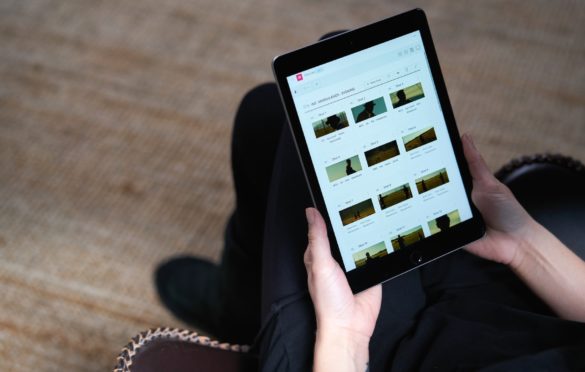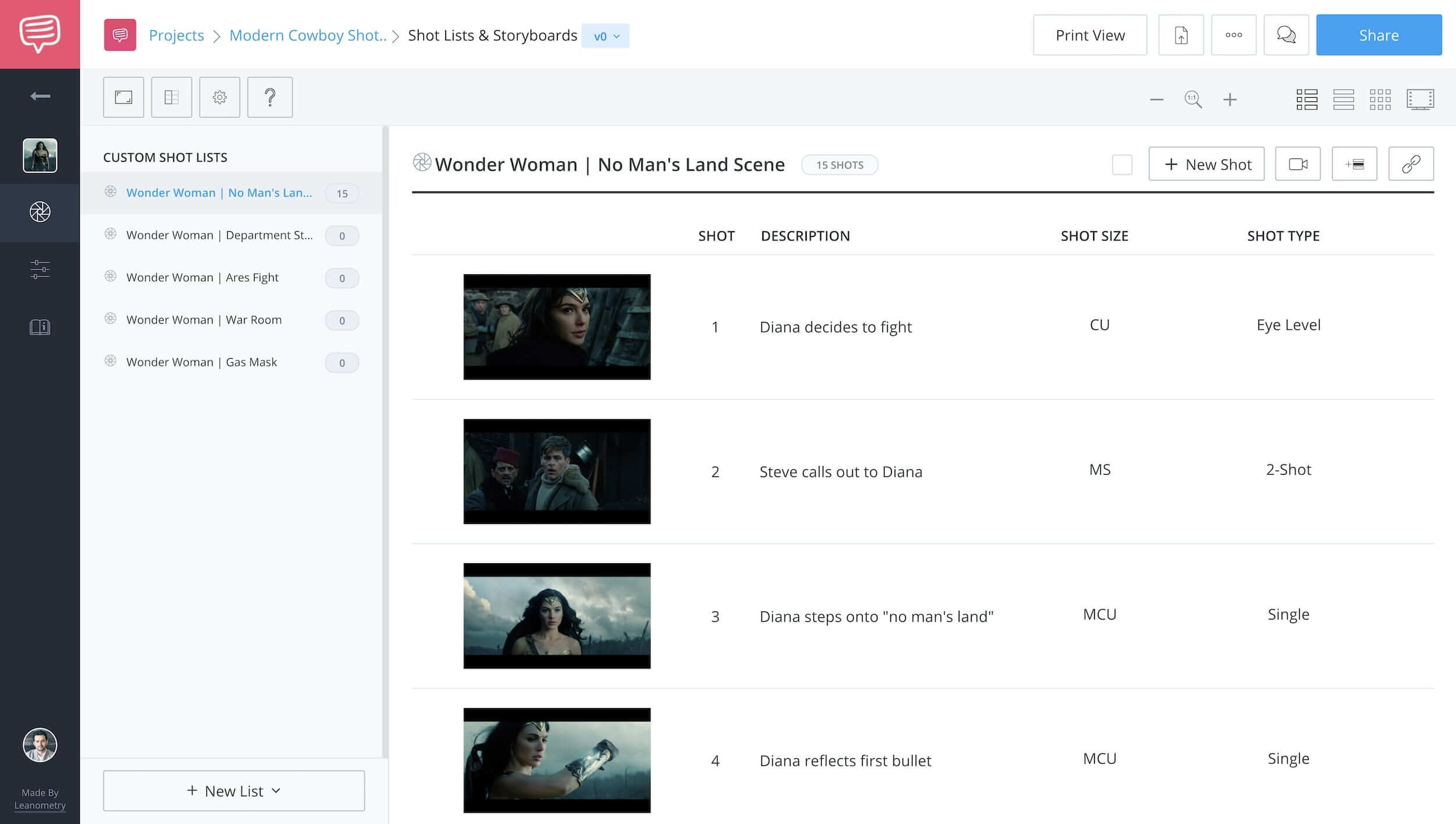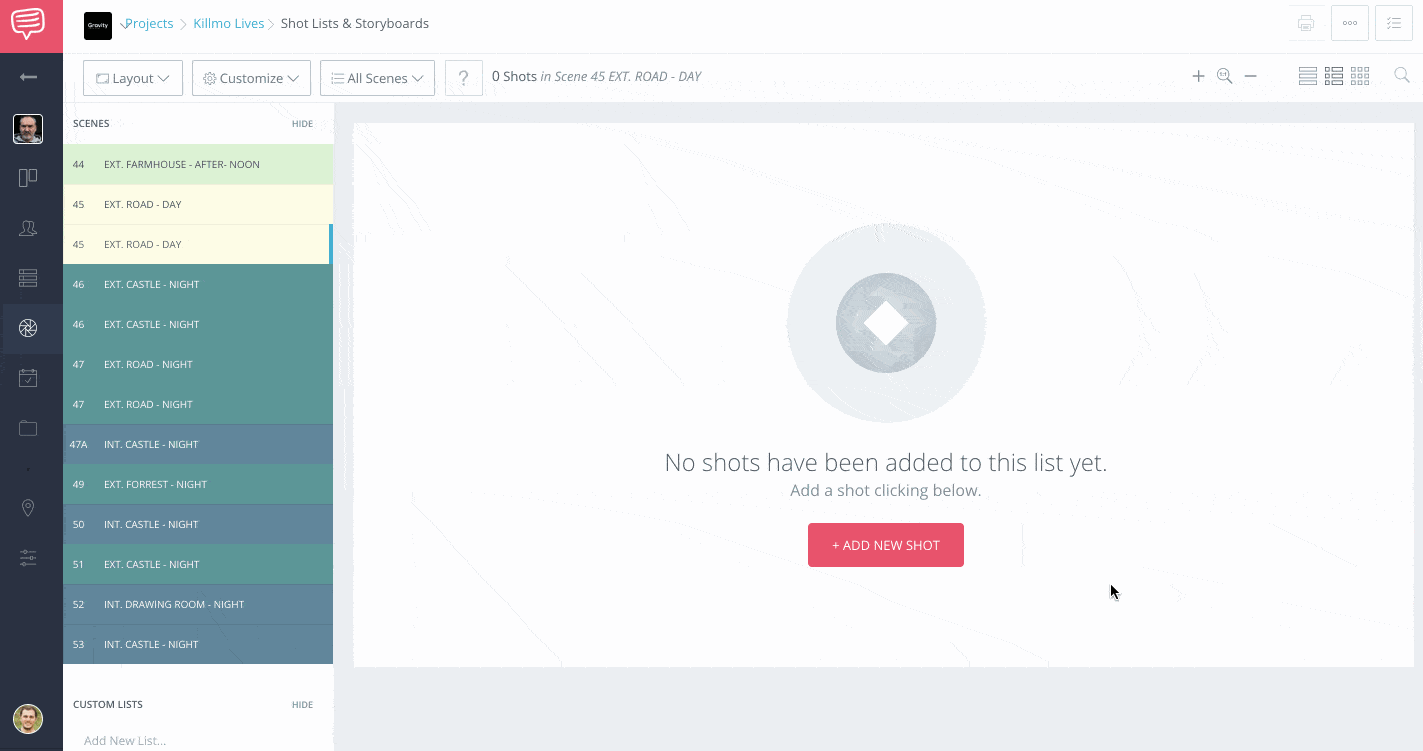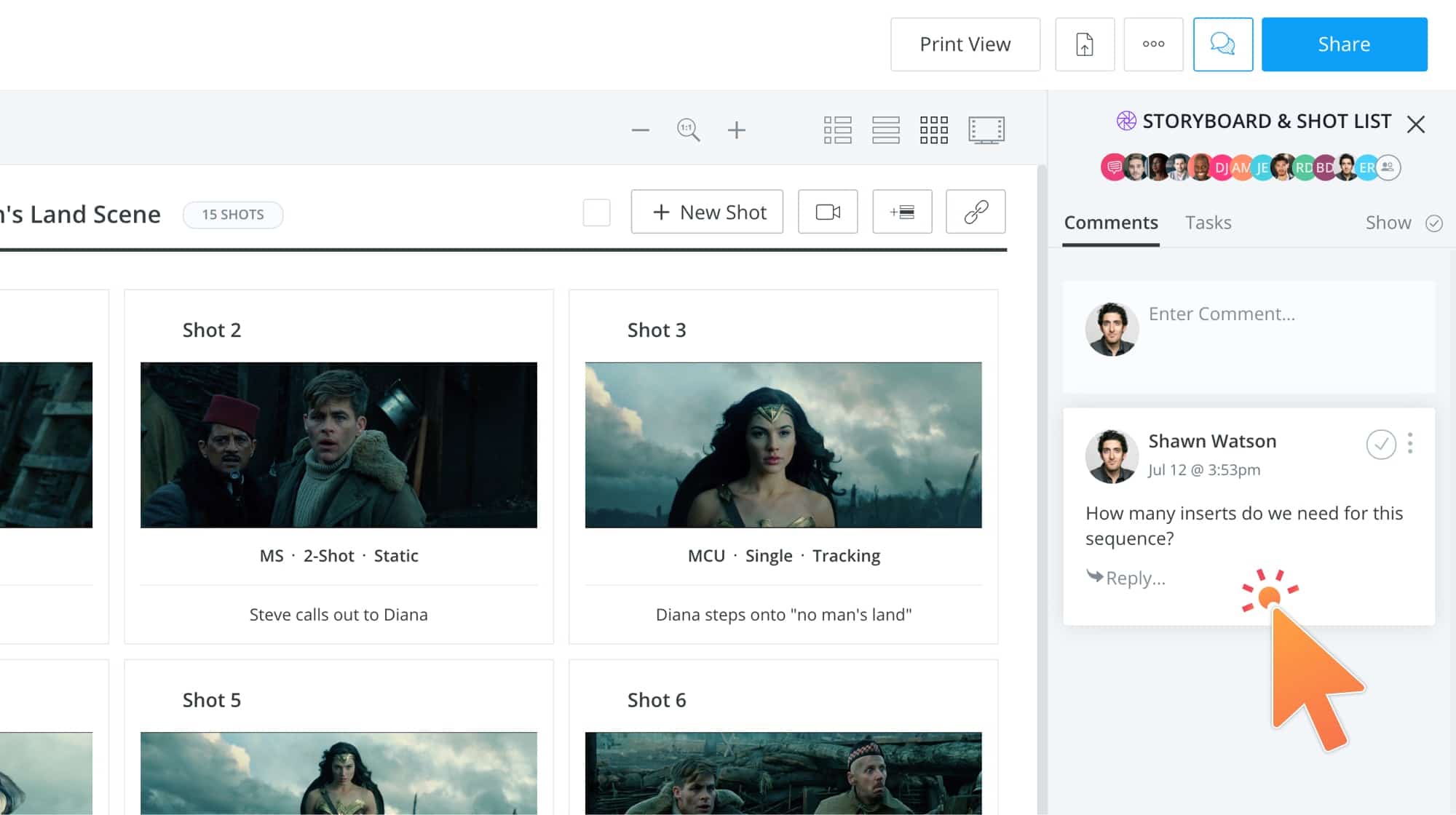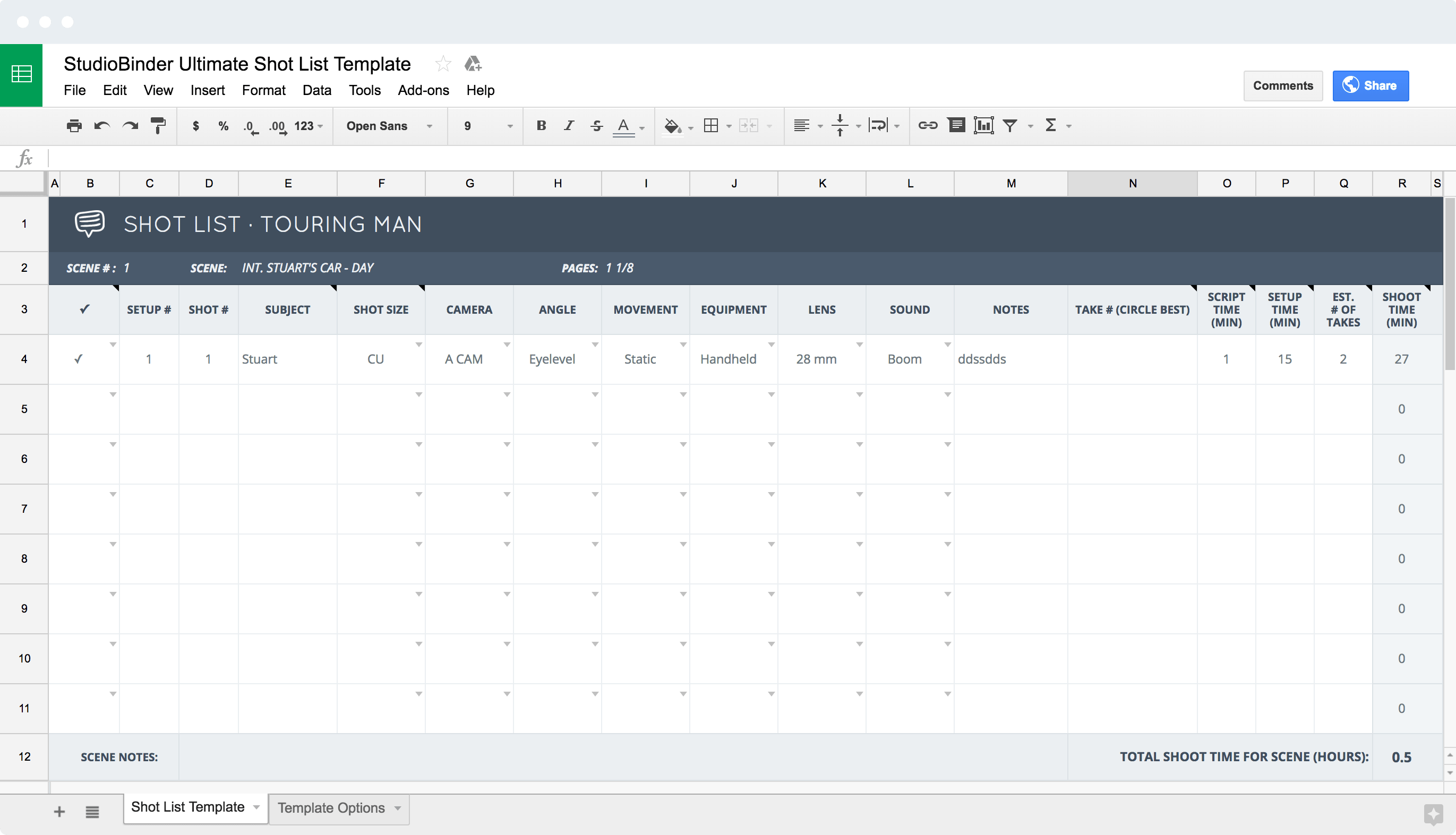A good shot list maximizes shooting time and limits downtime across all departments. In this post, we lay out the essentials of a shotlist with pro-tips on best practices.
We’re also going to walk you through StudioBinder’s shot list module so you can maximize your productivity. In the end, we’ve provided a shot list template pdf that you can use outside of StudioBinder.
Alright, time to start shot listing!
Shot List Definition
What is a shot list?
A shot list is a strategic document that lists all the shots to be shot in a specific shoot day. It’s a way for the director to clearly communicate the vision of the film, TV series, photography shoot or commercial with the DP and 1st AD. The shots list includes key details, such as shot size, type, camera movement, lens and gear requirements. A shotlist is like a shopping list to make sure you get every shot you need to tell the story.
Shot lists are not exclusive to filmmaking. You can build a camera shot list for a photography shoot, and, if you have multiple cameras, you can use a shotlist to specify which shots will be created with each camera.
What does a shot list look like?
See for yourself by jumping into the shot list example below. Change the layout and columns to see all of the customization options:
Example of Movie Shot List from Wonder Woman • Shotlisted in StudioBinder
You can add sketches, reference images, and color code your shots however you like. Add equipment, frame rates, and detailed descriptions to achieve total clarity for you and your team.
What is a shot list?
The anatomy of a shot list
A shot list can be as simple or detailed as you want. It is a roadmap that will get you to a finished project but there is a lot of flexibility and personalization you can bring to the process.
As detailed as shot lists can be, there are some core elements that every list should have:
- Scene Number
- Shot Number
- Shot Description
- Camera Movement
- Shot Size and Type
If you're still asking yourself "What is a shot list?" check out the video below where we explain the shot list anatomy and show you how to build one.
The Anatomy of a Shot List
Free Film ShotList Template
Basic shot list elements
Now that we've gone off the basic requirements of a shot list, let's go through StudioBinder's online shot list. Each element is designed to communicate vital information to your crew.
A good shot list will guide you through a smooth and productive shoot:
Each scene you shoot will require a unique approach and collection of specifications for you to capture the best images possible, so we designed our shot lists will the filmmaking process in mind.
StudioBinder shot lists can be customized to fit your needs so that the most important aspects of your shots can be emphasized and so that your creative goals can be achieved on set.
First, we're going to highlight some of the core elements that each shot list should have. In the following section, we'll get into just how detailed and specific you can make a shot list.
1. SCENE NUMBER
Scene numbers are extremely important in your StudioBinder project. They sync between your script, shotlist and schedule. You can also use color labels to identify different scenes or types of shots.
2. SHOT NUMBER
This is a reference number for the shot / row. Simply list out your shots starting at 1. Reset the shot number back to 1 for every new setup.
3. DESCRIPTION
Provide as much detail as you’d like for each shot. It could be anything from an insert description, an action in the scene, or a line of dialogue.
4. SHOT SIZE
Shot size defines the size of the subject in the frame (e.g., close-up, medium shot, etc).
5. SHOT TYPE (CAMERA ANGLE)
The shot type references the position of the camera in relation to the subject (e.g., eye-level, high angle, low angle, etc.).
A change in camera angle calls for a new setup in your camera shot list. If the camera angle changes during the take, phrase it as something like a low-med-high, which means the shot starts low, moves to a medium, and ends on a high angle. This can be added in the Description.
Here’s a comprehensive list of 50+ camera shots and angles commonly used in shotlists.
6. CAMERA MOVEMENT
Camera movement identifies any movements of the camera during the shot. Remember, complex camera movements are time-consuming to setup so use them sparingly.
How to Make a Shot List
Free Film Shooting List Template
Advanced shotlist options
Beyond the basic film shot list template elements, there are a number of details you can add. In StudioBinder, you can customize your shotlist with many additional columns to get as specific and detailed as you want.
In this section, we'll highlight these advanced features so you can see just how useful and detailed a comprehensive shot list can be.
7. STATUS (THE SHOT LOG)
Once the shot is complete, mark the row with the ✓ to track your progress.
Pro Tip: Marking shots as Nice-to-Have in advance helps everyone better prioritize the essentials on set—which is helpful if you start falling behind schedule.
8. SUBJECT
The subject is the focus of the shot. It can be a character, group of characters, a prop, establishing shot, etc. The subject helps your team plan when actors should report to set or when a prop or location needs to be prepped.
Pro Tip: Remember that insert shots are often the easiest to shoot, requiring minimal talent, crew and gear. Factor them strategically into your camera shot list while other shots are being prepped. It’s also a good idea to keep a list of insert shots on standby for shooting during downtime.
9. VFX
Here you can make a note of any VFX (visual effects) this particular shot might need. Make sure you VFX Supervisor is included when creating a shot list so they can advise on any special considerations needed while filming.
10. CAMERA
Designate which type of camera you're going to use and make sure to confer with your camera department so they are prepared. If you're on a multi-camera shoot, identify individual cameras or specialty cameras (e.g., drone, GoPro, security camera, webcam, etc.).
11. EQUIPMENT
Identify the camera equipment that will be supporting the camera (e.g., tripod, crane, dolly, etc.). This helps you anticipate the set up time for equipment changes.
12. CAMERA LENS
The Lens column helps your DP and assistant camera team (ACs) prep for upcoming shots. Changing the lens constitutes a new setup, and takes time to accomplish. Minimize setup time by grouping your shot list by lens setups.
13. FRAME RATE
The frame rate indicates if this shot will be normal speed, slow motion, or fast motion.
14. SPECIAL EQUIPMENT
If there are any specific pieces of equipment needed for a shot (e.g., a drone, an underwater housing, etc.) you can include that information here.
15. SOUND
Is a shot covered with a boom mic or a lav mic? Both? Is the shot MOS (without sound)? If you have a complex sound setup, add it to the Notes column.
16. LIGHTING
This is where you can make any specific notes about the lighting of this particular shot.
17. LOCATION
Where you shoot each shot is very important to scheduling and organizing your shoot. Moving your entire crew from one location to another is extremely time consuming so grouping shots by location is essential.
18. PREP TIME
Setting up for each shot take time and calculating that time accurately will make your shoot as efficient as possible. Meet with your department heads (e.g., Camera, Grip/Electric, ADs, etc.) so that these times are accurate and agreed upon.
19. SHOOT TIME
Based on the script time, setup time and estimated number of takes, the shot list template will automatically generate an estimated shoot time for every shot.
We also add an additional five minutes of padding to every estimate just to play it safe.
20. TOTAL ESTIMATED TIME
The Total Est. Time column will allow you to add the prep and shoot time. This lets the entire crew know when they should be finished with a particular shot and move onto the next one.
21. START TIME
This gives the crew a general idea of how the day is scheduled. When you calculate your set-up and shoot times for each shot, the start time can be estimated.
22. CAMERA SETUP
You can mark the end of each setup so the crew knows exactly when and where each change will take place. If you've included prep and shoot times, the setup line will automatically calculate time for the entire setup.
Pro Tip: Setups can eat up a lot of time over the course of a day. Once the camera is set with specific equipment (or lens), shoot as many setups with that gear before switching.
23. CUSTOM NOTES
Our film shotlist template has two notes sections: notes for specific shots and notes for the whole scene. These could be used in a variety of ways, including for setups, meal breaks, etc.
24. COLOR CODING
To add an additional layer of customization, you can also color code your shots. This way, you can group them by setup, location, actor, etc.
25. PRINT VIEW
If you would like to print out your shot list, the print view will include the reference image along with all the shot specs.
SHOT LIST CAMERA MOVEMENT TYPES
Camera movements in a shot list
Our shot list template includes the following camera movement terms as drop-downs so that you can build the most detailed camera shotlist.
| Camera Move | Description |
|---|---|
|
Static
|
When the shot is locked off, the camera doesn’t pan, tilt, zoom or change in any way. |
|
Pan
|
When you rotate the camera horizontally from a fixed location. |
|
Tilt
|
When you rotate the camera vertically from a fixed location. |
|
Pedestal
|
When the camera is moved vertically up or down (without tilting). |
|
Dolly
|
When you move the entire camera forwards and backwards along a track. |
|
Truck
|
The same as dollying, only you are moving the entire camera from left to right instead of forward and backward. |
|
Arc
|
Used in combo with dolly or truck to show a curve in the dolly track. |
|
Steadicam
|
When the camera is stabilized using a special rig onto the body of a specialized operator. |
|
Handheld
|
The camera is held by the operator without a stabilizer. |
|
Crane or Boom
|
When you have a shot that starts extremely high and moves to a lower position or vice versa. Often used for overhead and establishing shots. |
|
Zoom
|
When you zoom in or out of a subject. |
|
Rack Focus
|
This is more a technique than a move. Rack focus is when the focus changes quickly from one subject to another in the same shot. |
|
Dolly Zoom
|
A technique where the camera moves closer or further from the subject while simultaneously adjusting the zoom angle to keep the subject the same size in the frame. |
Mastering the Shot List: P.T. Anderson
Create a camera shot list
How to make a shot list strategically
Generating a shotlist can be a fun and creative process but choosing your shots is just the first step. For the shot list to be fully functional, it also needs to be strategic so that your shoot runs as smoothly and efficiently as possible.
Create a movie shot list in three steps:
- Write out your list of camera shots.
- Group the camera shots by setups.
- Reorder the setups into the most efficient order of shooting.
That’s the gist of it. But like most things, the devil’s in the details. Writing out a shot is easy, conceptualizing is hard.
Film Shot List Collaboration
Shot lists are joint efforts
Just like filmmaking itself, a shot list should always be a collaboration. After you've generated a list of which shots you want, the actual shooting scheduling can be generated.
This is where each department should be brought into the discussion. For example, if a shot needs special equipment like a process trailer, your camera department might say that this will require 3 hours to set up. When you realize that you can shoot 4 additional shots if you skip the process trailer, it becomes a question of priorities.
Shot lists can and should be a living document during the pre-production process. Once you've gathered input from your collaborators, you can make the most productive and efficient schedule.
Variables come into play with any production and the goal is to eliminate as many of them ahead of time. This begins with a solid shot list.
Shot List Collaboration
Collaboration in StudioBinder
In the past, you'd have to send your finalized shot list to your UPM, upload a PDF to an online file sharing site like Dropbox, and hold a meeting to see how the schedule will shift and what shots are feasible.
Example of shot list: Collaborate directly inside StudioBinder
Now, with StudioBinder, you can eliminate this process entirely. Since your shot lists are saved under your scene strips, your shooting schedule and call sheets automatically adjust.
Not to mention, your department heads can view, edit, and comment directly on the shot list.
Up Next
Create a shot list with StudioBinder
Now that you're an expert on what a shot list looks like and how it works, it's time to make your own! With StudioBinder's software, you can create a professional and functional shot list for your next project. We'll take you through the process, step-by-step, so you can get to work.
Up Next: Create a Shot List in StudioBinder →
Showcase your vision with elegant shot lists and storyboards.
Create robust and customizable shot lists. Upload images to make storyboards and slideshows.
